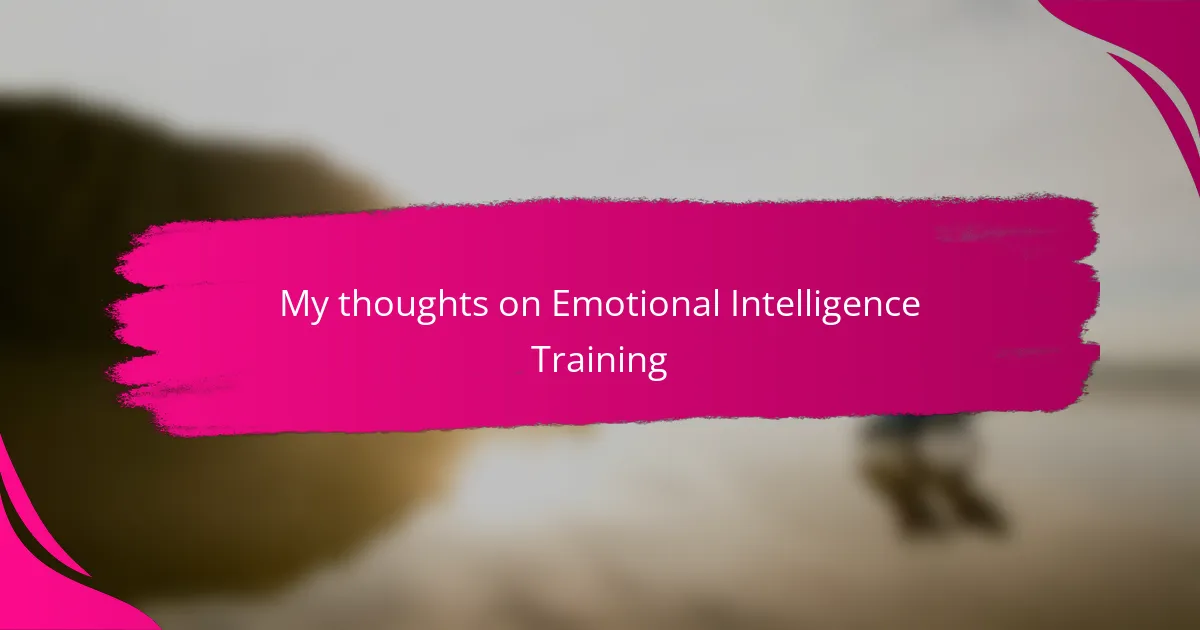Key takeaways
- Emotional intelligence in parenting fosters deeper connections by promoting empathy and understanding between parents and children.
- Practicing self-awareness, empathy, and emotional regulation helps transform conflicts into calm conversations, enhancing family resilience.
- Daily rituals like feeling check-ins and modeling calm responses create a supportive environment for children’s emotional development.
- Patience and consistency are vital in overcoming challenges in emotional intelligence training, making it a continuous learning journey.
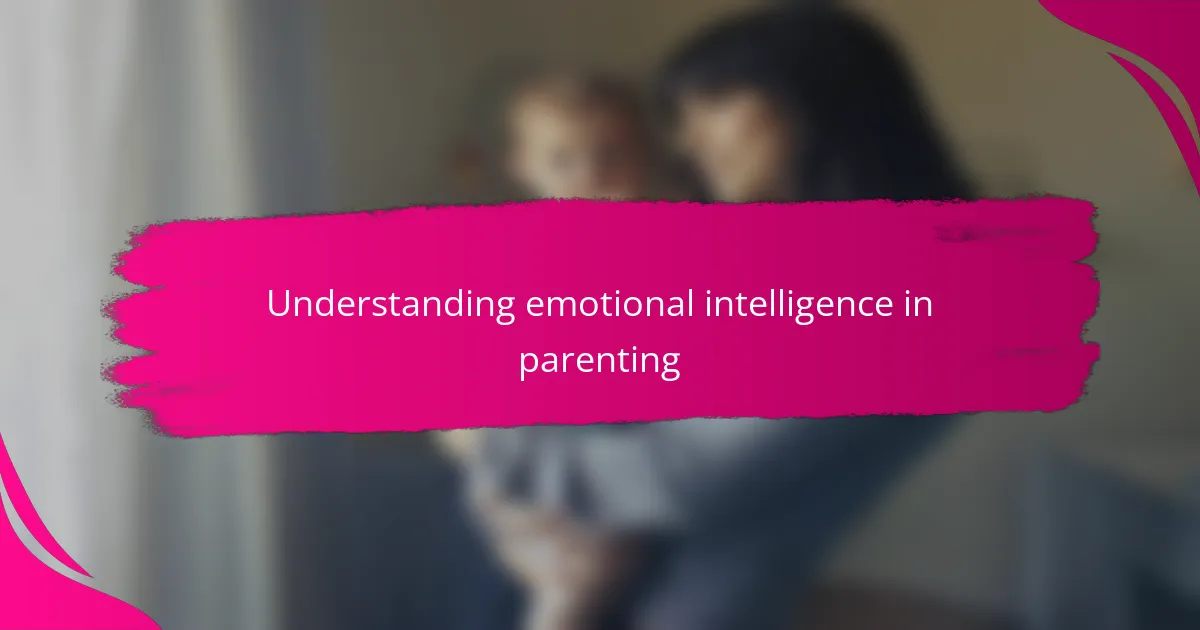
Understanding emotional intelligence in parenting
Emotional intelligence, to me, is the quiet skill that transforms the chaos of parenting into moments of connection. I remember when my child was frustrated over a homework problem, and instead of jumping to fix it, I paused to really feel what they were experiencing. That moment of empathy not only calmed them down but deepened our trust.
Have you ever noticed how kids mirror our emotions? When I began tuning into my own feelings, I saw how my mood directly shaped my child’s behavior. It made me realize emotional intelligence isn’t just about managing them—it starts with managing myself.
Understanding emotional intelligence means recognizing each emotion as a signal rather than a problem. I’ve learned to ask, “What’s this feeling teaching me about my child’s needs?” This shift helped me respond with patience and clarity, turning daily struggles into opportunities for growth.
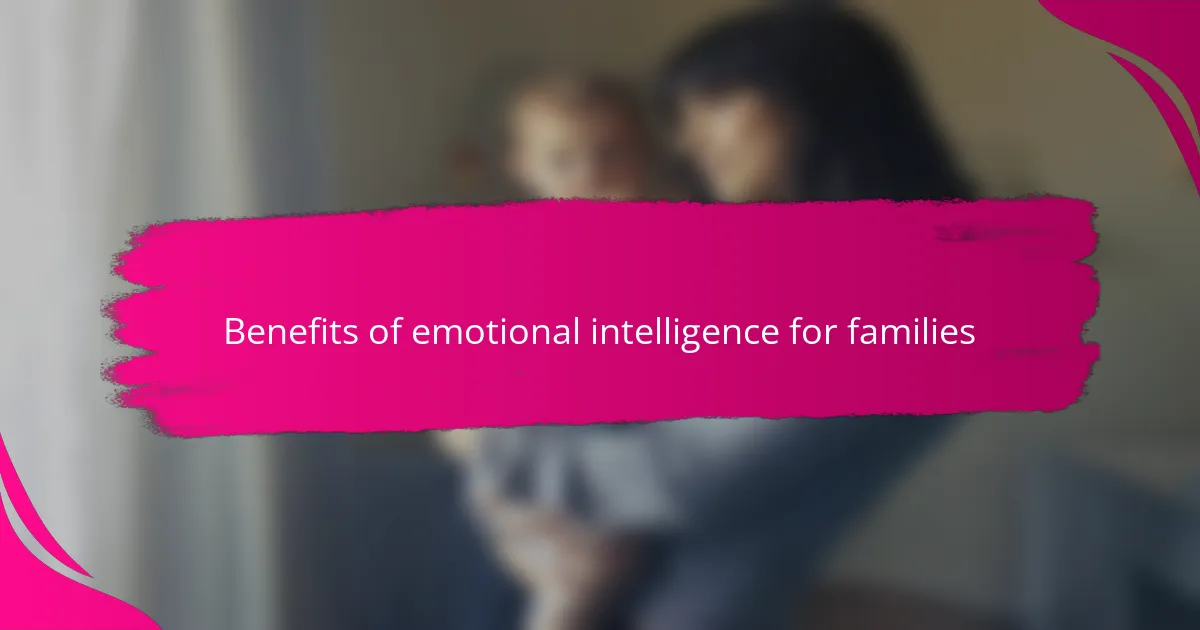
Benefits of emotional intelligence for families
One of the biggest benefits I’ve noticed is how emotional intelligence nurtures stronger family bonds. When we openly acknowledge and respect each other’s feelings, it creates a safe space where everyone feels heard. Have you ever seen the relief on a child’s face just because you really understood what they were going through? That connection is priceless.
It’s amazing how emotional intelligence helps reduce conflicts at home. Instead of reacting impulsively, we learn to pause and tune into what’s really going on inside ourselves and our kids. I’ve seen how this simple shift transforms tense moments into calm conversations, making our home more peaceful.
Beyond just less arguing, emotional intelligence teaches my family resilience. When emotions are managed well, setbacks don’t feel like disasters. I remember a time when a disappointment could have ruined the day, but sharing feelings honestly turned it into a moment of growing stronger together. Isn’t that what we all want for our families?
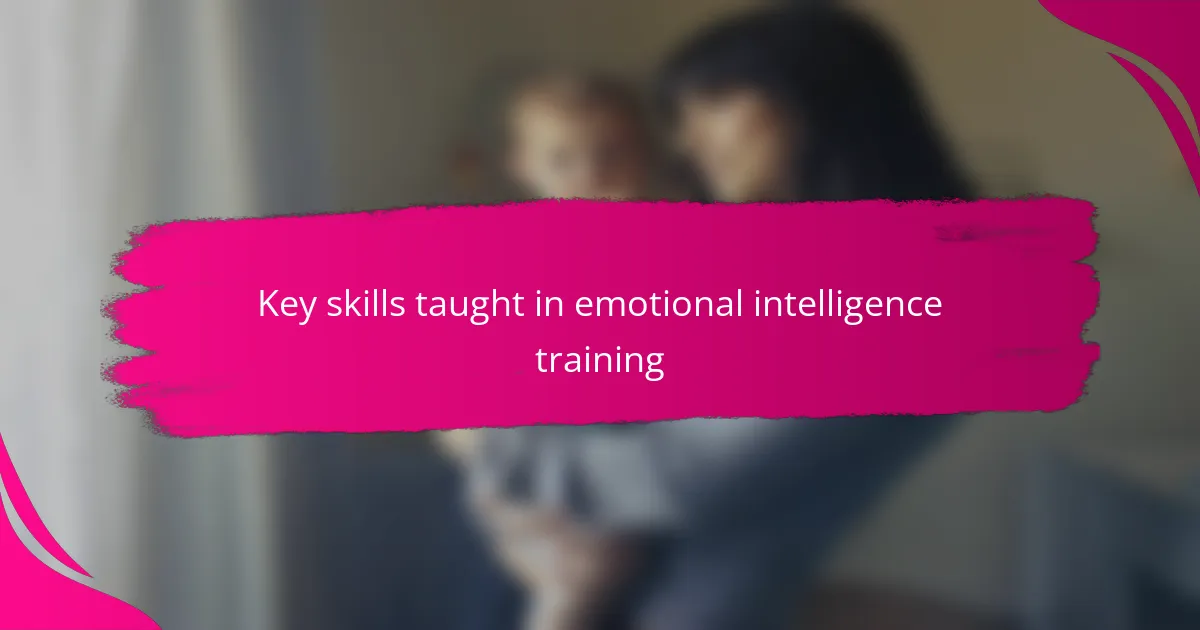
Key skills taught in emotional intelligence training
Emotional intelligence training often focuses first on self-awareness—recognizing our own emotions as they arise. I found this skill surprisingly powerful; by naming my feelings, I was less likely to react harshly during stressful parenting moments. Have you tried just pausing to identify what you’re feeling before responding? It can change the entire dynamic.
Another key skill is empathy—the ability to truly understand and share in our child’s emotions. I recall a night when my teenager was clearly upset but reluctant to talk. Practicing empathy helped me connect without pressure, and eventually, they opened up. Being able to put myself in their shoes has made communication so much more genuine and less confrontational.
Finally, emotional regulation is critical, especially in heated situations. Learning techniques to stay calm, like deep breathing or taking a brief break, has saved me from many potential conflicts. I’ve discovered that when I manage my emotions well, I model healthy behavior for my kids, teaching them to do the same. Doesn’t that feel like a gift we can pass on?
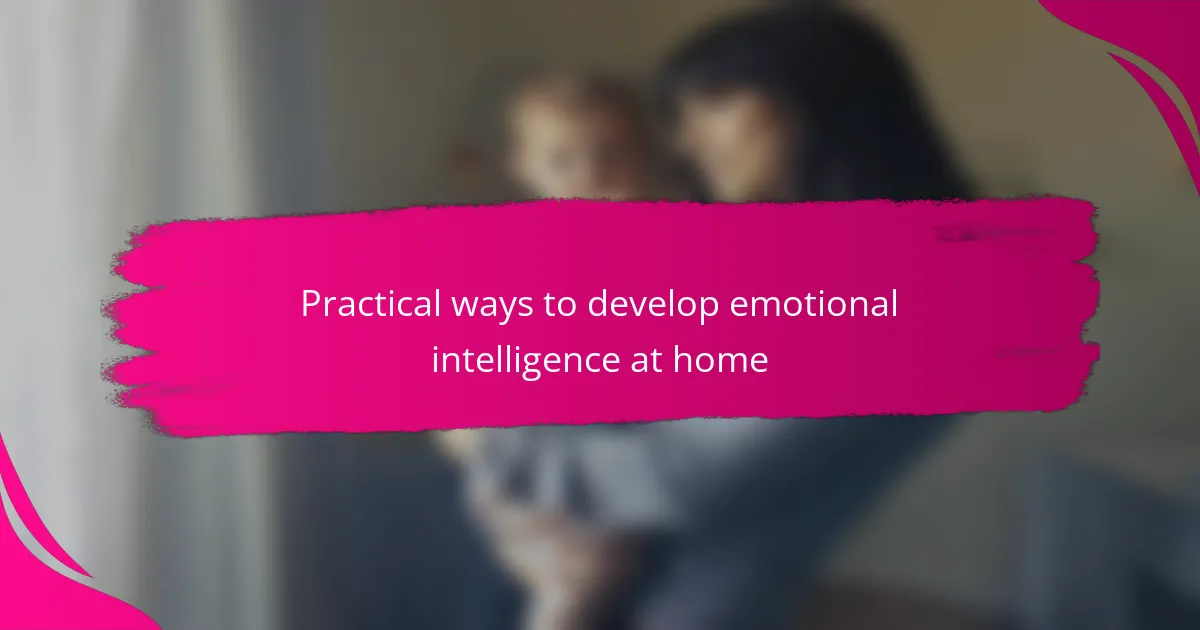
Practical ways to develop emotional intelligence at home
One practical way I nurture emotional intelligence at home is through dedicated “feeling check-ins.” We set aside a few minutes each day to share how we’re feeling, using simple words or even colors. It might sound small, but this ritual has opened doors for honest conversations and helped my kids build their emotional vocabulary.
I also make it a point to model calm responses during conflicts. When tensions rise, I take a breath and explain what I’m feeling out loud—like saying, “I’m frustrated because I want us to understand each other.” This not only defuses the moment but teaches my children how to express themselves without blame or anger. Have you noticed how kids mimic the emotional habits they see?
Lastly, I encourage problem-solving together rather than prescribing solutions. When my child faces a challenge, I ask questions like, “What do you think we could do next?” This approach empowers them to think critically about their emotions and choices. From experience, this shared approach makes them feel supported and confident, turning emotional moments into valuable learning experiences.
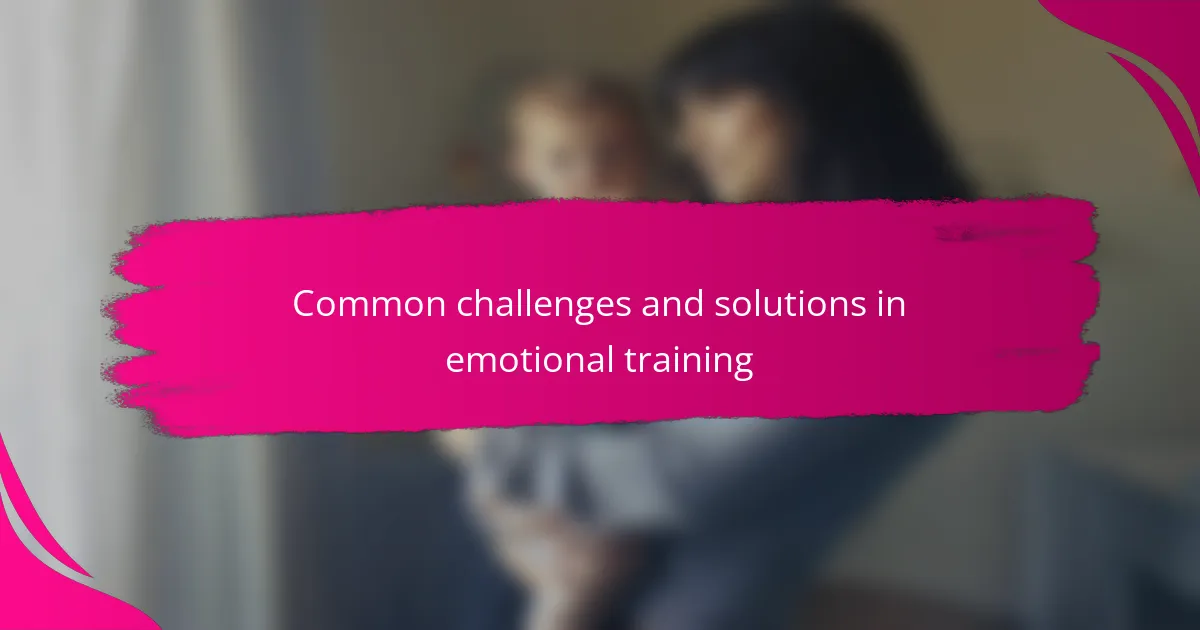
Common challenges and solutions in emotional training
Emotional intelligence training isn’t without its hurdles. I’ve often felt the frustration when my child resists opening up, leaving me wondering if I’m reaching them at all. But I’ve learned that patience and consistency—the quiet twin pillars—gradually build that bridge, turning resistance into slow but steady connection.
One common stumbling block is controlling our own emotional reactions during heated moments. I’ve caught myself snapping only to regret it later. What has helped me is practicing self-regulation techniques, like a deep breath or a brief timeout, which reset the moment before things escalate. These small pauses can feel like a lifeline in the heat of parenting chaos.
Sometimes, it’s hard to know where to start or how to keep the training going amid busy family life. I found that embedding emotional check-ins into daily routines, like during dinner or bedtime, makes the process feel natural rather than another task. Have you tried weaving these small habits into your day? They’ve made all the difference in keeping emotional learning alive at home.
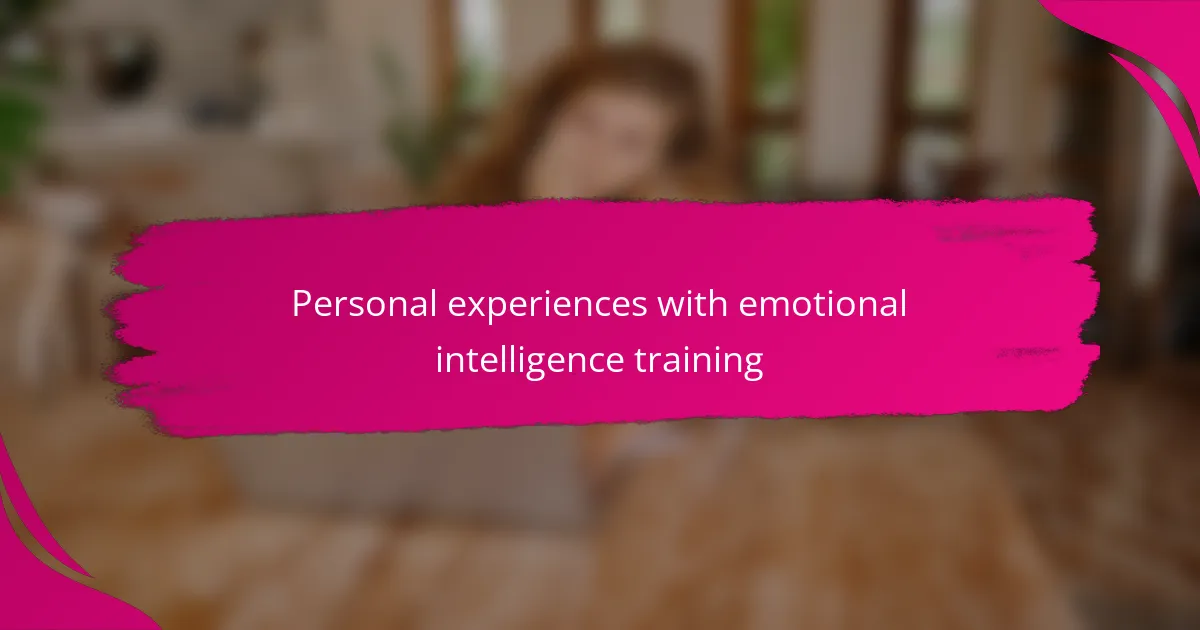
Personal experiences with emotional intelligence training
When I first took an emotional intelligence training course, I was surprised by how much I overlooked my own feelings in the parenting journey. It wasn’t until I practiced recognizing and naming my emotions that I noticed a real change in how calmly I handled my child’s outbursts. Have you ever found that simply knowing what you’re feeling can defuse a stressful moment before it spirals?
One experience stands out vividly—I remember a session where we role-played difficult conversations, and it struck me how easy it is to react instead of respond. That exercise made me realize that pausing to understand my emotions is like hitting a mental reset button. Since then, I try to take that pause at home, which has softened many conflicts into conversations.
Of course, it’s not always smooth sailing. I recall moments when, despite the training, old habits crept back in, and impatience took over. But reflecting on those slip-ups helped me see emotional intelligence as a practice, not a perfect skill. What’s changed for me is the willingness to keep learning and showing up, even when it’s hard—that persistence feels like the true heart of emotional growth.
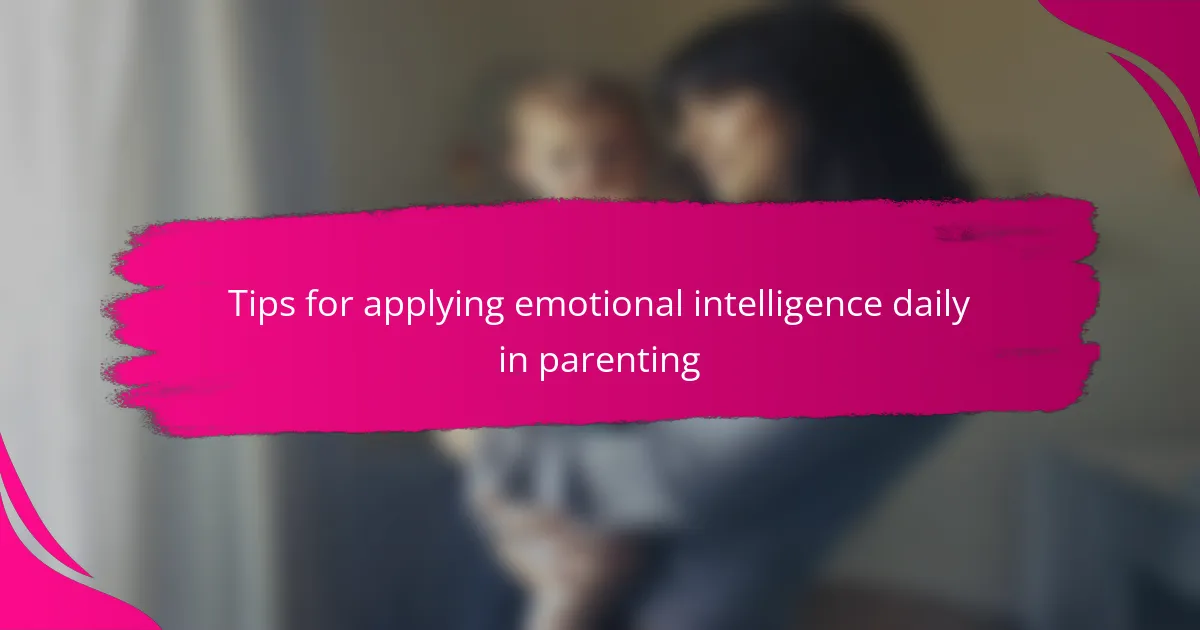
Tips for applying emotional intelligence daily in parenting
One tip I find invaluable is to pause before reacting when my child expresses strong emotions. In those moments, I ask myself, “What is really driving this feeling?” This pause lets me approach the situation with calmness instead of frustration, and I’ve noticed it changes the whole atmosphere in our home.
I also try to name emotions aloud—not just for myself but with my kids too. Saying things like, “You seem sad about that,” helps my children feel seen and teaches them that emotions are okay to express. Have you tried this with your kids? It’s a simple step that opens up honest conversations.
Another practice I rely on is encouraging problem-solving together rather than jumping in with immediate fixes. When I ask, “What do you think would help?” it shifts the focus from blame to action, empowering my child to understand and manage their feelings. From what I’ve seen, this shared approach builds both confidence and emotional resilience over time.
